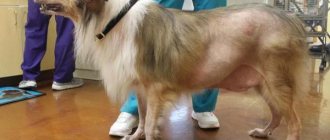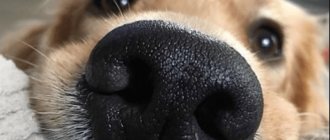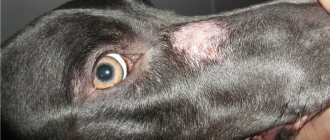Gastritis is one of the most common gastrointestinal diseases in dogs. It can occur for a variety of reasons, but in any case it causes serious discomfort to the pet and leads to a change in the chemical composition of gastric juice. Without treatment, gastritis can lead to serious complications, one of which is peptic ulcer of the stomach and duodenum.
To learn how to identify gastritis in a dog, why it occurs, and what effective treatment should be, see below.
Read in this article:
What is gastritis? Common causes Symptoms of gastritis in a dog Forms of gastritis: acute and chronic Diagnosis of the disease Treatment of the pet Dietary food: features and rules What can and cannot be fed to a dog with gastritis? How to reduce the likelihood of developing gastritis?
Common Causes
In 8 out of 10 cases, the cause of gastritis in a dog is poor quality nutrition. By giving your pet economy-class dry and liquid food, low-quality meat and low-quality vegetables, you risk his health, since they will inevitably lead to problems with the gastrointestinal tract.
Another common cause of gastritis is the wrong choice of food. When creating a diet for your pet, do not forget to take into account its individual characteristics (for example, level of activity during the day and the presence of chronic diseases).
The development of gastritis can be caused by mixing natural and industrial diets, overeating a pet, and even different meal times. Many diseases of the gastrointestinal tract or long-term use of antibiotics can lead to complications, one of which is inflammation of the stomach.
Other causes of gastritis in dogs:
- Violation of the temperature regime of food . The food you give your pet should be at room temperature. You should not give your animal food that you have just taken out of the refrigerator/freezer or that has been overheated.
- Allergy or individual intolerance to any product. Many owners don’t even realize this, so they don’t change their pet’s diet. As a result, inflammation of the mucous membranes of the stomach develops.
- Helminthic infestations. For many helminths, the mucous membranes of the stomach are a favorable environment for feeding and reproduction. They stick to them and begin to produce toxins, which leads to severe irritation and inflammation.
- Ingestion of foreign bodies (objects). Most often it is a bone or a small dog toy. Foreign objects get stuck either in the stomach or in the intestines, therefore disrupting the patency of the gastrointestinal tract and causing severe inflammation.
- Poisoning . It can be food or medicinal. Many owners, wanting to help the dog, give medications from their first aid kit. Even ordinary acetylsalicylic acid (aspirin) can cause gastritis in your pet.
Gastritis can also be caused by other reasons. For example, diseases of the endocrine system (diabetes mellitus, adrenal insufficiency, etc.) often lead to irritation and inflammation of the mucous membranes of the stomach. The cause of gastritis in your pet may be iron deficiency or hypovitaminosis C, B1, B2, B6 and B12.
There are many reasons that can trigger the development of gastritis in dogs. That is why we strongly do not recommend trying to make diagnoses on your own. If you suspect that your dog has gastritis, contact a veterinary clinic in Moscow and get examined by a specialist!
What is colic and its causes
Colic is understood as convulsive, painful, spastic contractions of the muscles of internal organs, following one after another.
Remember! Colic is not an independent disease, but a symptomatic complex that occurs with various pathologies of the digestive and excretory systems.
The causes of colic in dogs are:
- mixing natural and dry food into one meal;
- eating flour, sweet, fatty, fried, spicy foods;
- greedy eating;
- change of diet;
- overfeeding, snacking, eating on the go;
- excessive consumption or, conversely, complete lack of fiber;
- poisoning by low-quality, musty water or food, poisonous mushrooms, medicines, lead, household chemicals and poisons;
- intestinal infectious diseases: salmonellosis, parvovirus enteritis, coronavirus enteritis;
- parasitic diseases and protozoal infections;
- non-communicable diseases of internal organs: enterocolitis, gastritis, volvulus, pyelonephritis, urolithiasis, peritonitis, ulcer;
- dysbacteriosis;
- neoplasms in internal organs;
- intestinal obstruction;
- metabolic disease;
- enzyme deficiency;
- long transportation on uneven roads.
Colic of any etiology requires immediate contact with a specialist; severe spasms due to urolithiasis or peritonitis can cause rupture of internal organs and instant death of the family pet.
Symptoms of gastritis in a dog
The first thing you should pay attention to is pain and cramping in the stomach area. The dog does not allow its belly to be stroked, whines when probed, and may be aggressive and growl. The pain occurs periodically, intensifying in the acute phase and gradually subsiding during remission.
Other signs of gastritis in dogs:
- Changes in appetite . At first it simply decreases (the pet often leaves food in the bowl, begins to refuse favorite foods and treats), and then disappears completely and the dog stops eating.
- Vomit . It usually occurs after eating. The vomit consists of food particles, but blood clots and bile may also be present. This indicates that gastritis is severe.
- White plaque . It is present on the back of the tongue, while an unpleasant specific odor emanates from the mouth. In some cases, the coating on your pet's tongue changes its color from white to grayish.
- Frequent bowel movements . With gastritis, stool is liquid. In rare cases, constipation may occur, which then gives way to diarrhea. With chronic gastritis, bloating occurs in the abdomen, and rumbling may occur.
- Increased body temperature . On average, it increases by 0.5-2 degrees in acute gastritis; in the chronic form of the disease, the dog’s body temperature does not change and remains normal.
- Depression of general condition . The animal becomes lethargic, gets tired quickly, practically does not play and does not ask to go outside. The fur becomes dull and matte. The skin is too dry and dandruff may be present.
Additional signs indicating the development of gastritis include pallor of the mucous membranes (they often acquire a jaundiced tint), frequent belching, severe thirst, and excessive salivation (salivation).
If you notice even a few signs of gastritis in your dog, immediately make an appointment with a professional veterinary gastroenterologist. Do not risk the health and life of your pet - refuse self-medication!
Constant severe pain in your pet
Terrible pain (like an attack, but for about 2 hours), foam at the mouth, weakness. They gave me a small portion of the worms and did an enema because they thought it was worms (I ate a lot). After a while they gave me a little bit of pain. It seemed to help a little, but then it happened again. Now the pain continues. The puppy ate borscht and milk (fresh cow) today.
If your puppy experiences physical discomfort, accompanied by lethargy, apathy, weakness, he whines and has lost activity, this is a reason to contact a veterinarian. Especially if this condition continues for a long time.
Foaming at the mouth, increased appetite, paroxysmal pain may indicate helminths, damage to the liver, intestines, stomach, or tumor.
We do not recommend giving him tablets intended for humans. In addition, limit your diet. Do not feed the animal meat products, but boil the milk in advance. If the puppy’s condition worsens and his appetite slowly decreases, we recommend taking the animal to the veterinarian to clarify the diagnosis.
Signals of illness
The animal cannot say that it is bothered by pain. Often puppies or adult dogs are unaware that they are sick. In this case, it is important to carefully monitor your pet's behavior. It is behavior that will help determine what is wrong with him. Remember that pain is the first sign of illness. Pay attention to the following behavioral features:
- The puppy whines, growls, howls, barks. If this behavior is constant, the dog makes sounds continuously, at rest, and they sound more like crying, this signals pain.
- Licks the sore spot. As a rule, dogs lick and bite places on the body that are the source of the disease.
- Drowsiness or lack of sleep. If the dog sleeps all the time, or, on the contrary, has lost peace, this indicates paroxysmal pain.
- Loss/increase in appetite, thirst, or refusal to drink water. If your pet has pain in the mouth or stomach, he may refuse to eat or drink. Inflammatory processes, on the contrary, increase thirst.
- Rapid breathing. A clear symptom of pain.
- Mobility. If the puppy literally cannot find a place for himself, he constantly turns around, lies down and immediately gets up, and this happens all the time, it means that something is bothering him. Often this is the stomach, intestines.
- Aggression for no reason. If you touch, for example, a dog’s stomach, it may growl and grab your hand.
- Convulsions, unusual behavior, activity.
- Constipation or diarrhea, difficulty defecating, which provokes discomfort.
In addition, signs of pain may include a clouded, “sad” look, strange movements, and difficulty getting up. If the puppy greedily absorbs food, and after a while loses his appetite, he begins to vomit and bloat, do not hesitate, it is better to seek help from a specialist, no self-medication.
Causes of pain
The nature of the pain and location depends on what exactly is bothering the animal. Pain is caused by malignant tumors, problems with the liver, stomach, intestines and its obstruction.
A common problem in young dogs is worms. They are triggered by uncooked food, raw meat, and dirty dishes.
If a puppy picks up food on the street, it also becomes the cause of parasites.
Foaming at the mouth
Foam from a dog's mouth indicates poisoning, intoxication, worms that have begun to actively parasitize in the intestines.
Foam also indicates serious and dangerous diseases: rabies, plague, epilepsy, internal edema. Foam comes out of the mouth if there are foreign objects in the cavity, or food or bones are stuck between the teeth.
In any case, this is an alarming symptom, which, in combination with apathy, weakness, and pain, indicates an illness.
Poisoning with poison causes foam at the mouth, but in this case, the symptoms are pronounced, without timely help the animal will die. Experts do not recommend giving your pet regular human medications to relieve pain. You can use activated carbon, but it is better to immediately provide qualified assistance.
What to do if your puppy gets sick?
- If the puppy is sick, and its appearance and behavior cause concern to the owner, immediately contact the nearest veterinary clinic.
- Typically, the veterinarian will begin the examination with palpation to determine the location of pain, the presence of an obstruction or tumor. If a tumor or swelling is detected, the animal will need an x-ray.
- Also, the doctor must conduct a thorough bacterial analysis of the puppy’s feces for helminths in order to establish the exact cause of the illness.
- In addition, the analysis allows us to identify hidden bacteria that are harmful to the dog’s health. After establishing the cause, the veterinarian will prescribe treatment and vaccinate. Remember, if the puppy gets worse over time, you cannot self-medicate, this will only prolong the problem!
Source: https://dogcentr.ru/voprosyotvety/postoyannye-silnye-boli-u-shhenka.html
Forms of gastritis: acute and chronic
Acute gastritis . This is an acute inflammation of the mucous membranes of the stomach, which often develops against the background of other diseases (for example, acute infections). It is accompanied by severe and sharp pain in the stomach, a rapid deterioration in the pet’s condition, and a rapid increase in symptoms (weight loss, increased body temperature, increased bowel movements).
Chronic gastritis . The main feature of this form is its asymptomatic development. It occurs independently or against the background of acute gastritis. Since symptoms are not expressed, inflammation develops over several years. With chronic gastritis, the pet experiences gradual weight loss, frequently changing appetite, and vomiting that is not associated with food intake.
If acute gastritis is not treated effectively, then in 85% of cases it becomes chronic.
Diagnosis of the disease
The key to a quick and successful recovery for your pet is an accurate diagnosis. To make a diagnosis, the veterinarian examines the dog. It includes external examination and palpation of the painful area. Analysis of gastric contents and scatological studies are carried out. If necessary, gastric radiography, ultrasound and biopsy of the mucous membrane are used.
Only a veterinary specialist after examination will be able to make an accurate diagnosis and prescribe effective treatment.
Pet treatment
Treatment of gastritis in dogs is aimed at eliminating the cause that led to this disease, and depends on the form of the disease. To relieve the inflammatory process and eliminate individual symptoms, medications are used.
Treatment:
For acute gastritis, it is recommended to follow a fasting diet (1-2 days) with free access to drinking water. In this case, the stomach is lavaged with a 1% sodium chloride solution or another solution prescribed by a veterinarian.
If the body is dehydrated, droppers are prescribed. Separately, medications are prescribed aimed at restoring and subsequently protecting the mucous membranes of the stomach. Vitamin preparations and mineral complexes are prescribed.
In case of chronic gastritis, the pet is prescribed medications aimed at eliminating inflammatory processes. At the same time, you must adhere to a special diet prescribed by your veterinarian.
Instead of starvation, as is the case with acute gastritis, the pet should be fed in small portions, but often. In the chronic form of the disease, general medications are prescribed (antihistamines, antibiotics, anti-allergy drugs, etc.).
Additionally, depending on the signs of gastritis, other medications are prescribed: painkillers and antispasmodics, antiemetics, hemostatics, antipyretics, etc. Their action is aimed at restoring the normal well-being of your pet.
Dietary food: features and rules
It is always necessary to provide your dog with a proper diet, and even more so if you have gastritis. If your pet is accustomed to dry food, then choose diets from special dietary lines. Before doing this, be sure to consult a specialist.
Features of dietary nutrition for gastritis:
- Eliminate fish and meat completely . You can introduce them back into the diet from 10-14 days of gastritis treatment, but only in the form of minced meat (for example, mixed with liquid porridge).
- Add steamed vegetables to your diet. Prohibited vegetables include potatoes, tomatoes, peppers, as well as onions and garlic.
- Give your pet vegetable broths and herbal decoctions . This will ensure rapid recovery of his body.
- Introduce porridge into your diet . Veterinarians recommend giving your dog rice and oatmeal, previously diluted with warm water to a semi-liquid state.
First aid at home: how to relieve pain from an attack
In order to relieve pain from an attack, it is necessary to provide first aid to the animal at home. First of all, it is necessary to massage the abdomen, but it is carried out very carefully.
Important! If the abdominal cavity has significantly increased in size and become hard, this may indicate gastric volvulus. In this case, the dog must be taken to the clinic as soon as possible.
- After the massage, the pet is fed activated carbon . The dosage is calculated as follows: for every 10 kg of body weight, one tablet is given.
- For severe colic, (1 ml for every 5-10 kg of weight) or a mixture of No-shpa and Diphenhydramine (1 ml of each drug) is injected into the thigh muscle
- If there are no solutions for injections, but there are tablets, they are crushed , mixed with warm water and injected into the anus in a volume of 10-20 ml. After the acute attack is over, your pet should be seen by a doctor.
What can and cannot be fed to a dog with gastritis?
You can give:
- lean meats (beef, rabbit, turkey),
- deboned fish,
- beet,
- carrot,
- low-fat cottage cheese, milk, kefir,
- rice, buckwheat, semolina and oatmeal.
It is forbidden to give:
- cheese,
- eggs,
- canned fish,
- peas,
- cabbage,
- corn and millet porridge,
- sausage and other smoked meats.
How to reduce the likelihood of developing gastritis?
Remember that it is easier to avoid a disease than to cure it. Veterinarians have prepared several useful recommendations that will help avoid the development of gastritis in your pet. And the very first of them concerns the dog’s nutrition. To prevent stomach inflammation, select only high-quality food and do not give your pet food from the table.
Other prevention recommendations:
- Do not mix natural and industrial food. Decide what your pet’s diet will be, taking into account its individual characteristics.
- Keep a close eye on your dog while walking. She should not pick up unfamiliar objects or try to swallow them.
- Visit your veterinarian regularly. This is necessary for vaccination and anthelmintic therapy.
- Don't forget about hygiene procedures. An animal can bring pathogenic bacteria from the street onto its paws and fur.
- Never self-medicate or give medications from your home medicine cabinet. If you have any suspicious symptoms, contact your veterinarian.
Remember that the dog's health largely depends on your attention and care. Do not ignore the signs of gastritis - if you have any suspicions, contact a veterinary clinic and begin treatment!
Prevention
To reduce the risk of developing stomach and intestinal pain, the dog’s diet should be varied, balanced, and nutritious. The dog should receive high-quality food, only fresh products. There should always be clean drinking water in the bowl.
Do not neglect preventive deworming and immunization, since parasites, viruses, bacteria, and protozoa often provoke pain in the gastrointestinal tract. In order not to provoke digestive disorders, adhere to a regimen and a certain nutritional system.











